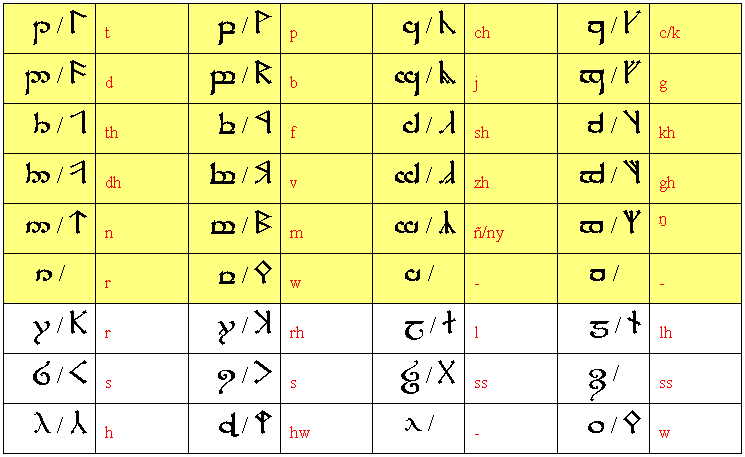
One of the earliest alphabets used in Middle-earth was the Tengwar. It was a highly structured, yet very flexible writing system that could easily be written with pen or brush. The Tengwar's only drawback was that it was difficult to use when inscribing onto metal, stone or wood.
During the First Age, Elvish craftsmen in Beleriand developed a new alphabet that was almost entirely made from straight lines and could be easily engraved onto hard surfaces. This alphabet came to be known as the Cirth (meaning: "runes").
All of the primary Tengwar letters were composed of (at least) two elements: a vertical stem or "Telco" (representing air) and a curved bow or "Luva" (representing voice). Some letters also contained a horizontal bar. Likewise, all of the primary Cirth letters were composed of (at least) two elements: a vertical stroke and a diagonal stroke (representing voice?). Most of the diagonal strokes angle downward. If a Tengwar letter contain a horizontal bar, the corresponding Cirth letter will contain a diagonal stroke that angles upward. (There were also numerous additional letters that supplemented the Tengwar and Cirth primary letters. These additional letters did not necessarily follow any symbol conventions.)
Here is a Tengwar Chart for Sindarin. I have also added the corresponding Cirth letters. The Tengwar and Cirth primary letters are highlighted in yellow.

From this we can analyze the work of the Elvish craftsmen in Beleriand and see how they developed the Cirth alphabet from the Tengwar alphabet. We can observe the following patterns:
| Features in the Tengwar Alphabet | Equivalent features in the Cirth Alphabet |
|---|---|
| vertical stem (Telco) drops below the body of the letter | vertical stroke on left side of letter |
| vertical stem (Telco) rises above the body of the letter | vertical stroke on right side of letter |
| vertical stem (Telco) is the height of the body of the letter | letter contains horizontal or vertical symmetry |
| letter contains one curved bow (Luva) | letter contains one diagonal stroke (typically angling downward from the vertical stroke) |
| letter contains two curved bows (Luva) | letter contains two diagonal strokes |
| letter contains horizontal bar | letter contains diagonal stroke that angles upward from the vertical stroke. |
It is clear from these observations that the Cirth alphabet is as highly structured and flexible a writing system as the Tengwar alphabet. It is exceedingly phonetic and can easily be adapted for use by most any language. It exhibits all of the qualities of world-class writing system. This may help to explain why the Cirth spread throughout all the lands of Middle-earth and was used, in one form or another, by most every race including Elves, Dwarves, Hobbits, and Mankind.
Source:
"The Lord of the Rings" by J. R. R. Tolkien
Volume III, "The Return of the King", Appendix E
Houghton-Mifflin
ISBN 0-395-27221-1
|
Back to Main page. Last updated: November 2, 1999 |
Copyright © 1995-1999 Daniel Steven Smith Frequently Asked Questions |